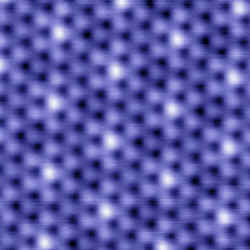Mystery in a Simple Metal

Every solid state physicist learns first about metals like sodium, potassium, and cesium because they are seen as the simplest metals to understand theoretically. The unbound electrons act in many ways like a gas of independent particles in a large box, which simplifies calculations of their properties. But in the 20 September PRL a team describes some surprising properties of cesium that the simple theory doesn’t predict: The metal drastically enhances the magnetism of iron and cobalt atoms dispersed on a cesium surface. The authors do not have a complete explanation for the results but are certain that in the process of finding one, they will learn important lessons about the behavior of metals.
Gerd Bergmann of the University of Southern California (USC) in Los Angeles stumbled on some strange properties of cesium when working on other experiments that used cesium surfaces. Alkali metals–the class that includes cesium–“should be the simplest thing one can imagine,” says Bergmann, so he investigated the anomalies and has reported several of them.
In his latest experiments, Bergmann and Holger Beckmann (formerly of USC) sprinkled metal atoms on cesium surfaces and measured the atoms’ magnetic moments–the strength of the tiny bar magnet that each impurity atom resembles. They used cobalt and iron as the impurities (in separate experiments) and spread them so thinly that neighboring impurity atoms were too far apart to interact. They also covered these preparations with more layers of cesium to find the moments of cobalt and iron as “bulk” impurities.
To detect the small atomic moments, the team employed the anomalous Hall effect: With a magnetic field in the z-direction and a current flowing in the y-direction, any conductor creates a so-called Hall voltage in the x-direction because the electrons tend to curve in the magnetic field. By subtracting that “normal” Hall voltage (due to the applied field) from the total Hall voltage, the researchers detected the effects of the impurity atoms’ magnetic moments. With temperatures up to 20 K and magnetic fields up to 7 T, the team measured moments of between 7 and (Bohr magnetons) for both cobalt and iron, as surface and bulk impurities. Bergman calls this a “giant moment” compared with the “native” moments of 1.7 and for cobalt and iron respectively.
The standard theory of alkali metals would predict no effect on the moments, says Bergmann, and “one cannot imagine a much simpler system for the theory.” He thinks cesium should serve as a “model substance” to check the validity of current theories and believes the problem might be traced to an incomplete understanding of the interactions among electrons.
”I’m intrigued,” says Jack Bass of Michigan State University in East Lansing. But he says that other surprising behaviors in alkali metals have been controversial–observed by some research groups and not by others. According to Bass, a minority of experts believes that Bergmann’s previous data may be explained by an exotic state of electrons called a charge density wave. Bass is ambivalent about the presence of that state in the alkalis but feels that the new results “ought to stimulate experimentalists to think about how to make further tests and theorists to try to explain the anomalies.”
More Information
Papers from the 14 August 2000 PRL:Phys. Rev. Lett. 85, 1582 Comment 1


